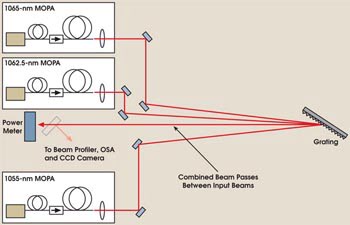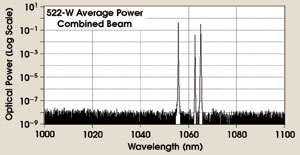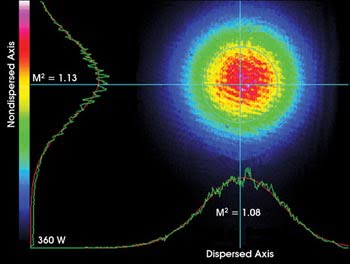
Three Fiber Lasers Are Better Than One
Spectral beam combining produces three times the power in a near-diffraction-limited beam.
Breck Hitz
As scientists and engineers push fiber lasers to ever-higher output powers, they have encountered severe nonlinear effects that are a stubborn roadblock to further progress. The fundamental problem is the high power density propagating for long distances inside the fiber. Many efforts are under way to decrease the power density (usually by increasing the size of the mode propagating in the fiber) or to decrease the length of fiber required to make a laser (for example, by increasing the pump absorption). An alternative approach is to combine the beams of several moderate-power lasers to create a single high-power beam.
Combining the light of several laser beams into a single beam is a more difficult undertaking than combining, say, the water flowing in several pipes into one pipe. That is because lasers are coherent and interfere with each other if they are not combined carefully. One way of carefully combining laser beams is to lock the phase of the different beams and combine them so they add coherently. That requires sophisticated (expensive) phase control of all the lasers and is difficult to achieve in practice.
A less complex approach is spectral beam combining, in which the beams are slightly offset from each other in wavelength and then combined. The different wavelengths mean that the beams cannot interfere with each other. The drawback of this approach is that it increases the bandwidth of the combined beam, but for many applications — such as industrial materials processing — that is not a serious issue.
Scientists at Aculight Corp. in Bothell, Wash., have spectrally combined the beams of three fiber lasers to generate 522 W in a single, near- diffraction-limited beam at 1 μm. They believe that this is the highest power yet reported for spectral beam combining with fiber lasers, and it also is significantly more power than has been reported for fiber-based coherent beam combining.
The scientists began with three ytterbium-doped fiber oscillator-amplifiers at 1055, 1062.5 and 1065 nm (Figure 1). They combined the three beams with a multilayer dielectric grating to produce the 522-W beam whose M2 was 1.18 in the axis of the grating’s dispersion (and 1.22 in the orthogonal direction). Thermal loading of the grating could ultimately limit the low-divergence power in the combined beam, so the researchers placed the grating in a Michelson interferometer and measured ~0.1-wave distortion at 1 μm, when a 1.5-kW/cm2 beam was incident on the grating.

Figure 1. Each of the three master-oscillator power-amplifier systems started with an external-cavity diode seed laser whose output was amplified first in Yb fiber preamplifiers and then in an Yb fiber power amplifier. To avoid stimulated Brillouin scattering in the fibers, the seed lasers were pulsed (5-ns pulses at a 10-MHz repetition frequency). These short pulses were gone before stimulated Brillouin scattering could build up to a significant amplitude. The powers reported in this article are average powers, but because the lasers’ duty cycle was 5 percent, the peak powers were higher by a factor of 20. Images reprinted with permission of Optics Letters. (MOPA = master oscillator power amplifier and OSA = optical spectrum analyzer).

Based on this measurement, they concluded that the grating could easily combine beams to produce kilowatt-level combined beams. Actively cooling the grating, or constructing it on a thermally conductive substrate, could result in even higher powers.

Figure 2. The combined beam consisted of three spectral components, one from each of the three lasers in Figure 1. The 522 W in the combined beam was 93 percent of the total power in the three individual beams. Conceptually, more spectral components could be added — Yb fiber lasers have a gain bandwidth of ∼60 nm — to produce significantly higher power in the combined beam.
The spectrum of the combined beam showed each of its three distinct spectral components, with out-of-band noise more than 60 dB lower than the signal (Figure 2). Although at lower (~360 W) levels the combined beam was diffraction-limited (M2 ~1.1, Figure 3), its beam quality was slightly degraded (M2 ~1.2) at the 522-W level.

Figure 3. At 360 W, the combined beam was diffraction-limited (M2 ~ 1.1). At 522 W, the combined beam quality was similarly excellent, at M2 ~1.2.
The scientists believe that the degradation resulted from a small amount of thermal-mechanical drift in the beam-combining alignment and expect to correct it in future experiments. Because this degradation mechanism is not fundamental, they predict that significantly higher outputs could be obtained without sacrificing beam quality.
Optics Letters, Feb. 15, 2007, pp. 349-351.
/Buyers_Guide/Lockheed_Martin_Laser_and_Sensor_Systems/c167